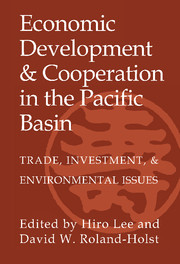 Economic Development and Cooperation in the Pacific Basin
Economic Development and Cooperation in the Pacific Basin Published online by Cambridge University Press: 19 May 2010
INTRODUCTION
By June 1, 1995, the World Trade Organization (WTO) – the successor institution to General Agreement on Tariffs and Trade (GATT) – had been notified of more than 130 regional arrangements (Bhagwati and Panagariya, 1996b). Today, with the exception of Hong Kong and Japan, every WTO member boasts of a membership in at least one regional arrangement. Neither the successful completion of the Uruguay Round nor the recent peso crisis in Mexico has been able to reverse the rising tide of regionalism. Having already concluded Free Trade Area (FTA) agreements with its neighbors in Central and Eastern Europe, the European Union (EU) is now beginning to bring the countries in North Africa into its fold. The United States, on the other hand, has set a target date of 2005 for the creation of the Free Trade Area of the Americas (FTAA), consisting of the entire Western Hemisphere. Germany has even made overtures for a Trans-Atlantic Free Trade Area (TAFTA) between the United States and the EU.
Historically, East Asia has not been enthusiastic toward preferential trading. Until recently, the only functioning preferential trading scheme in the region was the Association of Southeast Asian Nations (ASEAN) Preferential Trading Area (APTA), which was very limited in scope. Starting in 1989, the rise of regionalism in North America and Europe led to some rethinking in the region. In 1989, the forum for Asia Pacific Economic Cooperation (APEC) was created to bring the Uruguay Round to a speedy conclusion and to promote liberalization of trade and investment policies at the regional level. APEC, which has eighteen members currently, includes countries from not only East Asia but also the Americas.
To save this book to your Kindle, first ensure no-reply@cambridge.org is added to your Approved Personal Document E-mail List under your Personal Document Settings on the Manage Your Content and Devices page of your Amazon account. Then enter the ‘name’ part of your Kindle email address below. Find out more about saving to your Kindle.
Note you can select to save to either the @free.kindle.com or @kindle.com variations. ‘@free.kindle.com’ emails are free but can only be saved to your device when it is connected to wi-fi. ‘@kindle.com’ emails can be delivered even when you are not connected to wi-fi, but note that service fees apply.
Find out more about the Kindle Personal Document Service.
To save content items to your account, please confirm that you agree to abide by our usage policies. If this is the first time you use this feature, you will be asked to authorise Cambridge Core to connect with your account. Find out more about saving content to Dropbox.
To save content items to your account, please confirm that you agree to abide by our usage policies. If this is the first time you use this feature, you will be asked to authorise Cambridge Core to connect with your account. Find out more about saving content to Google Drive.